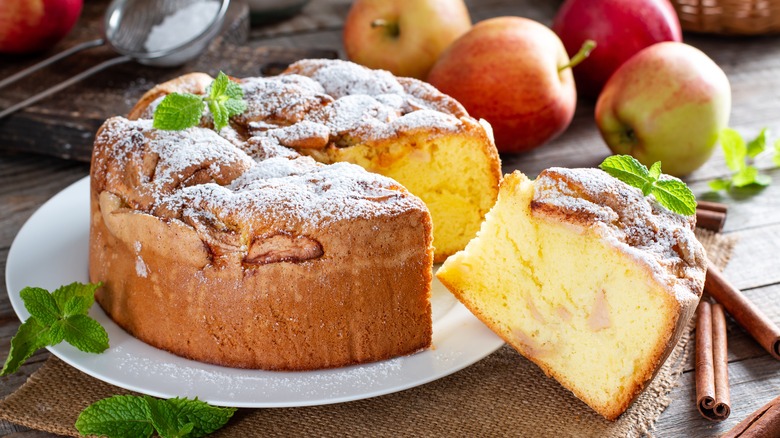What's The Best Varietal To Choose For Your Next Apple Cake?
From common kinds you'd find in any grocery store to the heirlooms hidden away on farms, there are over 7,500 varieties of apples growing around the world. And although they're related, apple varieties have incredibly distinct flavor profiles, textures, and uses — so when it comes to choosing one for a specific culinary purpose, the task can be a little daunting. Apples for eating are easy, a purely preference-based decision, but if you're baking an apple cake, not all varieties are created equal.
First and foremost, you've got to consider the texture. Apples used in baking should be firm and crisp, with enough heartiness of structure to stand up to heat. The apples shouldn't become overly soft in the oven, because they'll come out mealy and mushy in the final baked product. Many recipes, like a simple Cinnamon Apple Cake or a Tuscan Apple Cake, will call for folding in apple slices or pieces, and you'll want the fruit to hold some of its shape and pleasant firmness — but even in the recipes that call for pureed apples, you don't want to overdo the apple's moisture lest it affect the bake.
The tart Granny Smith apple is a popular baking choice and is generally easy to find. Varieties like Pink Lady, Honeycrisp, Jonagold, Winesap, and Rome will also stand up well. Golden Delicious and McIntosh are a little less firm, but if you want their flavor, they'll do well cut in pieces or pureed rather than sliced.
When finding an apple flavor, rely on the recipe
Speaking of flavor, that's the next factor to consider when choosing a variety for your apple cake. Although, in many ways, the flavor will come down to a matter of preference, it's important to look at the rest of your recipe then consider the sweet-tart ratio of the apple variety. A Croatian Apple Cake and a Jewish Apple Cake contain a lot of sugar, with even some sugar sprinkled on top, so a more tart apple variety like Granny Smith or Pink Lady would be a good choice to not overdo the sweetness. If the recipe calls for a lot of spices (think cinnamon or nutmeg), a sweet, strong variety like Braeburn won't be overwhelmed by the blend.
Don't feel like your cake has to commit to just one variety, though — pairing sweet and tart or strong and mild apples is an easy way to find just the taste you're looking for. McIntosh apples are known for their flavor, but since they're less firm, they're best mixed with more structurally hearty varieties so that things don't get too mushy. Jonagold has a honey sweetness, so you'll find balance if you pair it with something more tart.
A few apples to avoid when baking
Since firmness and flavor are the key ingredients when choosing a variety, the time of year also matters. Grocery stores will keep apples stocked in produce sections all year round, but apples do have a growing season — depending on where the fruit is being grown and the variety, apple season runs from late July to early November. If you can find an in-season apple variety and avoid the off-season apples for your cake, it's going to taste and feel its freshest. Since you can't bite into an apple at the grocery store or farmers market, you can also test freshness by looking for soft spots, bruises, and discoloration and smelling for a pleasant apple fragrance.
Although you are looking for freshness, there are some apple varieties that are great on their own or raw in salads but will fall apart or lose their flavor if you put them in the oven. Red Delicious, Gala, and Fuji are generally too soft for baking and will often come out tasting grainy and mealy or will mess with the texture of your apple cake. It's best to leave those on the shelf or just stick with snacking.


